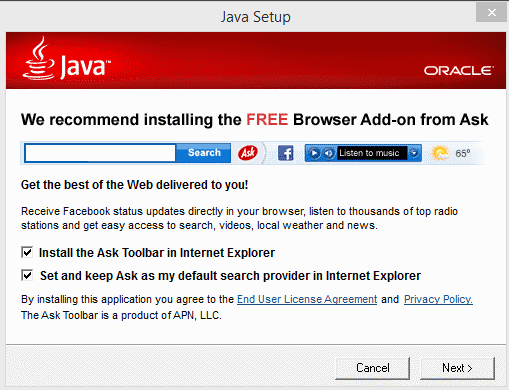Why the first program installation file may not always be the best pick

Downloading a software program is a straightforward process, right? You visit the developers website or a third-party download portal, click on the download link, wait until the download finishes, and install the program on your system afterwards.
While that works out well, especially for paid programs, you may benefit from looking around first on download pages or websites before you start the actual download.
A couple of examples: If you go to the popular portal download.com, you often download the company's own installer instead of the full installer of the program itself. Why? Download.com says it is to improve security and such, while many believe that it is just for throwing adware at you while you are installing software so that they can make a couple of bucks from that in revenue.
If you plan to install Java by Oracle or Adobe Flash Player, you may get additional software included with your download. Adobe integrates McAfee Security Scan Plus if you do not uncheck the box there, while Oracle the Ask Toolbar.
And if you go to KC Softwares, you find a total of four different installers for some of their products.
If you search on those websites, you find additional installers that you can use that are clean and come without additional, often unwanted, programs.
If you search around, you may find full offline installers for a particular product, or portable versions that do not even need to be installed at all.
- Rule 1: Net or Stub installers ship more often with third-party offers, while offline installers do not that often. While that is not always the case, it is in your best interest to pick the offline installer whenever available, as it reduces the risk of getting an installer with adware, and also provides you with the full setup file that you can run as often as you want on as many machines without re-download.
- Rule 2: If a portable version is offered, it is usually best to pick it as portable programs are not installed and therefor won't run third-party installers when you run the program.
- Rule 3: Some download portals wrap programs in third-party installers. The best way to avoid this from happening is to not use those portals, but to search for the programs you are interested in on other portals that do not use this practice.
Security software such as the new Malwarebytes Anti-Malware 2 picks up on potentially unwanted programs (PUP) more than a couple of years ago. It can happen that installation is blocked when third-party offers are noticed in the installer.
One of the interesting aspects of this phenomenon on Windows is that this is not exclusive to shady developers who by to earn revenue by pushing third-party programs on user systems, but that large companies use the very same methods for the same goal.
These larger companies on the other hand usually make available versions of their applications without third-party offer.
Advertisement




















Unwanted add-ons are much less a problem in the Linux universe. For Windows downloads I usually check SourceForge for a FOSS version first, and then maybe Freewarehome.com — Freewarehome has been around for ages, and it’s almost always reliable. As has been noted (on GHacks, I believe), nearly all other software download sites have clever “Download Now” buttons and links which install various kinds of malware instead of the program you’re after.
Or you can use DDownloads from: http://ddownloads.net/index.php/blog/241-ddownloads-v3-0-released
a reliabele software utility that provides only direct download links for hundreds of applications
I trust FileHippo, FilePuma, and MajorGeeks as places to download from without getting the ‘bonus’ of an installer included with my download. I am not happy with Cnet or Tucows. Upon reading this post I searched for ‘good software download sites’ and unfortunately the few hits that I clicked on gave highest marks to Cnet and Tucows.
If I read about a software that I want to try and the link there takes me to Cnet, I then do a search for the software at my preferred sites or the developer’s site. If I can’t avoid downloading from a place that has not yet earned my trust, I make a system image before starting. Bad things have happened to me before that a restore point would not remedy.
If anyone can pipe in with any more really trusted sites to add to my list of trusted sites, I would appreciate it. Also if I am trusting a site that is not as good as I now think, I would like to know that also.
This is why I love ninite.com
The OneNote installer is a good example. It’s free and new this week. They provide an online installer (stub) and it uses Microsoft’s app-streaming technology.
Is there a regular installer? I haven’t been able to find one and I don’t know how to capture the downloaded files and make my own installer.
There is a free program that will uncheck everything for you
http://unchecky.com/
I agree with Sammy.
Unchecky is designed specifically to catch and warn you of the sneaky add-ons, toolbars, extensions, etc which installation packages try to slip by you during the process.
I’m not sure if Martin has reviewed the program, but it’s certainly a program which warrants a look.
I have ;)
Whenever I install new software that I have never used before, I usually install it via virtual OS, that way I can see what it does to the OS if anything, just a kind of extra precaution. That way after I check it out I can easily restore the virtual os to prior to installing it.
That’s a good tip. Another option would be to use a sandboxing application.
I saw your Sandboxie article last month, but I thought apps still installed to the system then only ran in the sandbox if you told them to?
You can install apps in the sandbox.